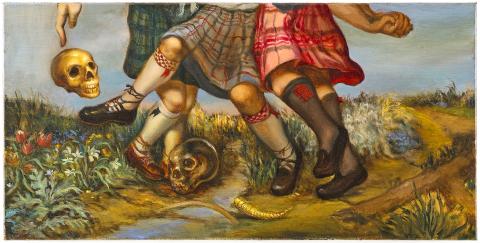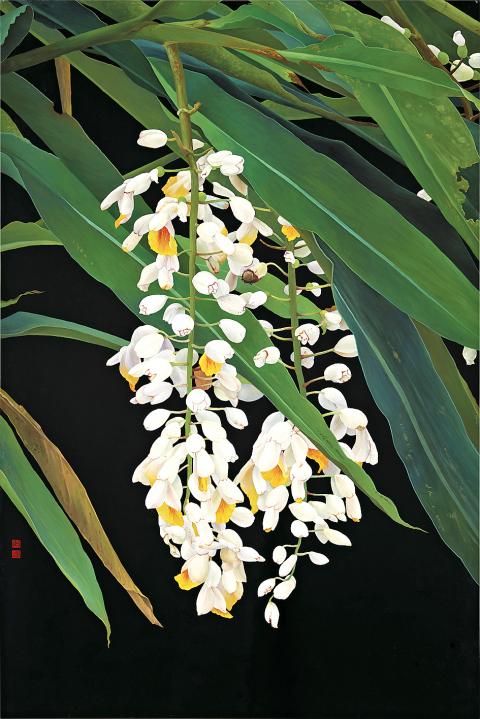The first edition of the Yilan-based art festival, Parallax 2017 (映像節), debuts with a repertoire of site-specific projects, audio-visual installations, performances and a screening program of short video, animation and experimental film. The festival is hosted in the former Chungshing Paper Mill (中興紙工廠), an abandoned paper factory that operated since the Japanese colonial era until it closed down in 2000. The festival’s curatorial framework ties closely with the context of ruins, and explores the concept of a zeitgeist, or spirit of the times, and its process of preservation and damage over time. Headlining the cross-disciplinary program is Ryoji Ikeda’s larger-than-life digital installation Data.Flux powered by 12 projectors and loudspeakers. Ikeda is known for creating works with clean aesthetics and mathematical precision that speak to the nature of sound and image. Stories About Weather by Hong Kong’s Lee Kit (李傑) is a site-specific installation made of video and readymade objects based on the artist’s surveillance of the installation process of an art project that appears in the same show. Another highly anticipated project is Ghost Mountain Ghost Shovel (鬼丘鬼鏟) art collective’s simulation of a fictional museum event that occurred 100 years ago. For this work, online registration is required for specific viewing times that are randomly assigned by a lottery system.
■ Chung Hsing Cultural and Creative Park (中興文化創意園) 6-8, Zhongzheng Rd Sec 2, Wujie Township, Yilan County (宜蘭縣五結鄉中正路二段6-8號) , tel: (03) 969-9440. Opens Thursdays to Tuesdays from 10am to 6pm and Saturdays from 10am to 8pm.
■ Until Dec. 10

Photo Courtesy of IT Park
Chen Wei-yi’s (陳偉毅) solo exhibition Pristine Scintillation (淳縷芳澤) is a luscious display of photorealistic lacquer paintings and jewelry boxes that feature plants and flowers characteristic of Taiwan’s natural habitat. For years, the artist specialized in lacquer painted objects until 2013, when he began painting on flat surface. Chen uses cashew lacquer, an oil-based paint originating from Japan. The material takes days to dry, which sets up a patient rhythm to his painting process. The images of plants, composed as meticulously rendered still-lifes, are depicted against a mysterious black background that glimmers with the natural reflection of lacquer. The painting Camouflage (保護色) is a humorous piece that shows a green feathered bird hidden in a leafy branch. Shell-flower (月桃心領) captures a flower in bloom that extends itself outward from a cluster of leaves. One of the leaves is broken and possibility eaten by predators, sporting edges that are brown and dry. In other pieces, the artist has chosen the theme of banana groves, which are commonly seen around his hometown in Nantou County.
■ Caves Art Center (敦煌藝術中心), 91, Fujin St, Taipei City (台北市富錦街91號), tel: (02) 2718-2091. Opens Tuesdays to Saturdays from 11am to 7pm.
■ Until Dec. 10

Photo Courtesy of Cave Art Center
Taiwanese artist Chen Ching-yuan (陳敬元) is known for painting fantastical, anecdotal scenes from grim, timeless other worlds that speak to the state of human existence. His solo exhibition, The Spider on Ship (船上的蜘蛛), at IT Park Gallery presents a series of recent paintings created during his residency at Glenfiddich brewery in Scotland, where he was greatly inspired by the natural scenery, the many ancient legends and myths and the companionship of other resident artist friends. The title of the exhibition is a metaphor for the artist’s current state of mind. He says he sees his creative process as weaving an ongoing “script that plays on and on of the past, the present and the future.” Chen intuitively takes text and images from history, combines myth and facts and creates pictorial narratives that lure the viewer into a space of deep contemplation. Across the River, The Flower Still Growing depicts three pairs of legs in traditional Scottish stockings and leather shoes, entangled in a competitive moment of kicking around two skulls. Grail is a back-turned profile of a naked man balancing a pile of plates on top of his half-developed head. White With Shadow shows a suited man kneeling beside a seated woman, concealing her face with his tall hat, as if telling her a secret.
■ IT Park Gallery (伊通公園), 2F, 41, Yitong St, Taipei City (台北市伊通街41號2 樓), tel: (02) 2507-7243. Opens Tuesdays to Saturdays from 1pm to 9pm.
■ Until Dec. 30

Photo Courtesy of Parallax
Then and Now: Modern and Contemporary Photography in Taiwan (彼時此刻—台灣近現代寫真) is a display of photographs from the collection of the National Museum of History in Taipei that traces the culture of photography and its record of society in Taiwan. Photography was first brought to Taiwan by the Japanese in the 19th century. The show begins with official and journalistic photographs that were created during the Japanese colonial era, then extends into images of common folk and everyday life after the Chinese Nationalist Party (KMT) takeover. There is also a special section dedicated to photographic documentation of the museum’s architectural transformation and surrounding changes in the last century. Under Japanese rule, the museum was set up as the display hall for agriculture. The building once featured distinct Japanese characteristics, which were later renovated into Ming and Qing Dynasty palace styles by the KMT. The show throws back to times when photography was not as accessible and common as it is now, framing the art of image-making in a local context.
■ National Museum of History (國立歷史博物館), 49 Nanhai Rd, Taipei City (台北市南海路49號), tel: (02) 2361-0270. Opens Tuesdays to Sundays from 10am to 6pm.
■ Until Jan. 7
The Taipei Art Awards, organized by the Taipei Fine Arts Museum, is a juried competition that begins with an open call process and results in one Taipei Art Award recipient, one Audience Choice Award recipient and 13 finalists who together present their works in a group exhibition. This year’s Taipei Art Award (台北藝術獎) exhibition is held at the Museum of Contemporary Art, Taipei. The award recipient Wang Yu-Song’s (王煜松) multi-media project Hualian White Lighthouse is inspired by a lighthouse in his hometown that he had read about, but never seen. According to the artist, he later learned that the lighthouse had been blasted apart and thrown into the sea to expand the Hualian harbor. Wang set off on a metaphorical journey to find the lighthouse, walking along its alleged location and carrying a steel piece of it into the sea. Also included in the exhibition is Wu Chi-Yu’s (吳其育) 15-minute, two-channel film Nose-dive, which takes the context of the 1996 Third Taiwan Strait Crisis as its departure point to explore its impact on Taiwan’s destiny.
■ Museum of Contemporary Art, Taipei (台北當代藝術館, MOCA, Taipei), 39 Changan W Rd, Taipei City (台北市長安西路39號), tel: (02) 2552-3720. Open Tuesdays to Sundays from 10am to 6pm.
■ Until Feb. 4

This year will go down in the history books. Taiwan faces enormous turmoil and uncertainty in the coming months. Which political parties are in a good position to handle big changes? All of the main parties are beset with challenges. Taking stock, this column examined the Taiwan People’s Party (TPP) (“Huang Kuo-chang’s choking the life out of the TPP,” May 28, page 12), the Democratic Progressive Party (DPP) (“Challenges amid choppy waters for the DPP,” June 14, page 12) and the Chinese Nationalist Party (KMT) (“KMT struggles to seize opportunities as ‘interesting times’ loom,” June 20, page 11). Times like these can

June 23 to June 29 After capturing the walled city of Hsinchu on June 22, 1895, the Japanese hoped to quickly push south and seize control of Taiwan’s entire west coast — but their advance was stalled for more than a month. Not only did local Hakka fighters continue to cause them headaches, resistance forces even attempted to retake the city three times. “We had planned to occupy Anping (Tainan) and Takao (Kaohsiung) as soon as possible, but ever since we took Hsinchu, nearby bandits proclaiming to be ‘righteous people’ (義民) have been destroying train tracks and electrical cables, and gathering in villages

Dr. Y. Tony Yang, Associate Dean of Health Policy and Population Science at George Washington University, argued last week in a piece for the Taipei Times about former president Ma Ying-jeou (馬英九) leading a student delegation to the People’s Republic of China (PRC) that, “The real question is not whether Ma’s visit helps or hurts Taiwan — it is why Taiwan lacks a sophisticated, multi-track approach to one of the most complex geopolitical relationships in the world” (“Ma’s Visit, DPP’s Blind Spot,” June 18, page 8). Yang contends that the Democratic Progressive Party (DPP) has a blind spot: “By treating any

Swooping low over the banks of a Nile River tributary, an aid flight run by retired American military officers released a stream of food-stuffed sacks over a town emptied by fighting in South Sudan, a country wracked by conflict. Last week’s air drop was the latest in a controversial development — private contracting firms led by former US intelligence officers and military veterans delivering aid to some of the world’s deadliest conflict zones, in operations organized with governments that are combatants in the conflicts. The moves are roiling the global aid community, which warns of a more militarized, politicized and profit-seeking trend